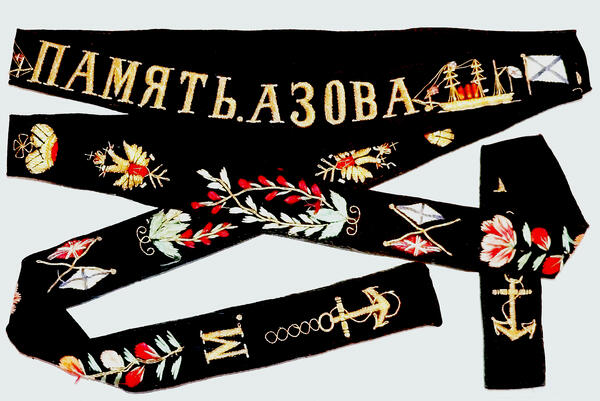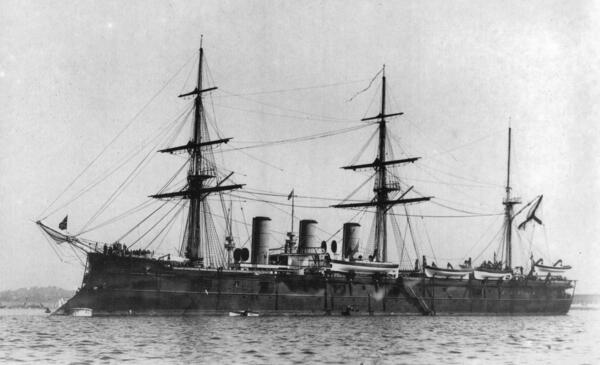One of the exhibits of the Kotlas Museum of Local Lore is a ribbon from the peakless cap of a sailor of the 1st-rank cruiser “Memory of Azóv”. At the ends of the ribbon, the letters “G” and “M” are embroidered. It belonged to Grigóry Matvéyevich Moséev, born in 1861, who served as a sailor in Kronstadt. The ribbon is sewn of black fabric and richly decorated with colored-thread embroidery.
Sailor's tape
Creation period
early XX century
Place of сreation
Russia
Dimensions
205.0x3.3 cm
Technique
factory-made, embroidery
Collection
Exhibition
0
Open in app#3
Unknown author
Sailor’s tape
#2
#5
Unknown author - Archive of photographs of ships of the Russian and Soviet Navy. Public domain: https://commons.wikimedia.org/w/index.php?curid=4360978
#4
The 1st-rank rank cruiser ‘Memory of Azóv’ is a Russian armored cruiser built at the end of the 19th century. It was intended for raid operations in the vastness of the world’s oceans. The ship was actively used, and was part of the formations of the Russian fleet in the Mediterranean Sea and in the Far East. In 1906, “Memory of Azóv” was renamed “Dvína” and was used as a training ship and a submarine floating base. In 1919 she was torpedoed by British boats and sank in the port of Kronstádt. She was salvaged and scrapped in 1923.
In the history of the Navy, the first mention of such black ribbons dates back to 1805, when British officers, as a sign of mourning for Admiral Nelson, tied black crepe ribbons of a rough silk fabric to the crowns of their hats.
The first ribbons in the Russian Navy appeared on the oilcloth hats of sailors in 1857 and on caps no later than 1872. Until then, only slotted letters and numbers were placed on the rims of sailor’s caps, which were painted over or enclosed with yellow cloth. The ribbon was supposed to have the name of the naval crew, the name of the ship, and sometimes the image of an anchor. In the 1870s, a black peakless cap with a ribbon was introduced in the Russian fleet, on which the name of the naval crew or ship was indicated. The exact size, shape of the letters on the ribbons, as well as the ribbons themselves, were approved for the entire rank and file of the Russian fleet on August 19, 1874. The exact length of the ribbon was also specified - 140 centimeters.
From 1921-1923, during in the Soviet Union, a new peakless standard was adopted, which is still in effect. The length of the ribbon was reduced, as well as a new cubic font, and instead of the name of the ship, since 1949 only the name of the fleet was included for reasons of secrecy. An exception was made only for the cruiser Aurora and the names of naval schools. Later, in the 1980s, the general inscription ‘Navy’ was applied to the ribbon. Now, the tradition of putting the name of the ship on the ribbons is returning, as it emphasizes the uniqueness of the duty station, and not just belonging to a particular fleet. A peakless cap with a ribbon has become one of the main symbols of the Russian fleet.
In the history of the Navy, the first mention of such black ribbons dates back to 1805, when British officers, as a sign of mourning for Admiral Nelson, tied black crepe ribbons of a rough silk fabric to the crowns of their hats.
The first ribbons in the Russian Navy appeared on the oilcloth hats of sailors in 1857 and on caps no later than 1872. Until then, only slotted letters and numbers were placed on the rims of sailor’s caps, which were painted over or enclosed with yellow cloth. The ribbon was supposed to have the name of the naval crew, the name of the ship, and sometimes the image of an anchor. In the 1870s, a black peakless cap with a ribbon was introduced in the Russian fleet, on which the name of the naval crew or ship was indicated. The exact size, shape of the letters on the ribbons, as well as the ribbons themselves, were approved for the entire rank and file of the Russian fleet on August 19, 1874. The exact length of the ribbon was also specified - 140 centimeters.
From 1921-1923, during in the Soviet Union, a new peakless standard was adopted, which is still in effect. The length of the ribbon was reduced, as well as a new cubic font, and instead of the name of the ship, since 1949 only the name of the fleet was included for reasons of secrecy. An exception was made only for the cruiser Aurora and the names of naval schools. Later, in the 1980s, the general inscription ‘Navy’ was applied to the ribbon. Now, the tradition of putting the name of the ship on the ribbons is returning, as it emphasizes the uniqueness of the duty station, and not just belonging to a particular fleet. A peakless cap with a ribbon has become one of the main symbols of the Russian fleet.
#6
MUK ”Kótlas Museum of Local Lore”
read morehide
00:00
00:00
1x
Sailor's tape
Creation period
early XX century
Place of сreation
Russia
Dimensions
205.0x3.3 cm
Technique
factory-made, embroidery
Collection
Exhibition
0
Open in app
Share




